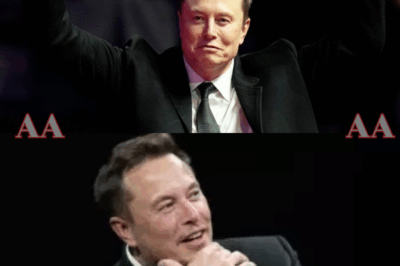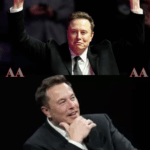Tesla has done it again. Elon Musk’s ambitious robotics project, the Tesla Bot, has taken a massive leap forward with the unveiling of Optimus Gen 3, the most advanced humanoid robot the world has ever seen.
Featuring a hyper-real OLED face and groundbreaking multitasking capabilities, this robot is poised to revolutionize the way humans interact with machines.
But as fans marvel at its ability to clean houses, cook meals, and manage daily chores, others are questioning whether Musk’s latest creation is a step too far — one that could ultimately replace human labor on an unprecedented scale.

A Game-Changer in Robotics: The OLED Face That Redefines Communication
At the heart of Optimus Gen 3’s innovation is its OLED face display, a feature that sets it apart from every other humanoid robot on the market.
Unlike previous versions, which relied on basic LED light patterns, the OLED screen allows Optimus to display facial expressions, emotions, and even textual information.
This marks a significant technological turning point, transforming the robot into a more approachable and human-like entity.
The OLED display, developed in partnership with Samsung, is an 8-inch panel that boasts sharp visuals, vibrant colors, and high contrast.
Tesla’s decision to incorporate this advanced technology into Optimus isn’t just about aesthetics — it’s about functionality.
The screen serves as the robot’s primary communication tool, enabling it to convey status updates, operating modes, and even subtitles for hearing-impaired users.
In industrial and consumer environments alike, this feature is expected to ease the uneasiness people often feel when interacting with lifeless machines.
Imagine asking Optimus to look up information about a recipe or a piece of technology.
Instead of simply speaking the results, the robot can display detailed visuals on its face, making interactions more intuitive and engaging.
For older adults or those unfamiliar with modern tech, this functionality could be a game-changer, offering a level of accessibility that most devices fail to achieve.
Multitasking Mastery: Cleaning, Cooking, and Beyond
While the OLED face is impressive, it’s Optimus Gen 3’s multitasking skills that have truly stunned fans.
Musk has promised that this robot will redefine what it means to have a “helper” at home, and based on early demonstrations, it’s clear that Optimus delivers on that promise.
From cleaning the house to cooking meals and managing chores, Optimus is designed to handle a wide range of tasks with ease.
During a recent demo, Optimus showcased its ability to vacuum carpets, wash dishes, mop floors, and even cook simple meals.
Equipped with a redesigned hand featuring 22 degrees of freedom, the robot can delicately grip fragile objects like glassware while also handling heavier items.
Its tactile sensors allow it to adjust its grip force depending on the object, ensuring safety and precision.
For example, Optimus can pick up a trash bag, open the lid of a bin, and properly dispose of waste without fumbling or making errors.
It can also fold laundry, water plants, and rearrange furniture — tasks that would otherwise take humans hours to complete.
The robot’s ability to seamlessly switch between jobs highlights its advanced AI system, which is trained through neural networks and sim-to-real technology.
This allows Optimus to learn from real-world situations and adapt to new environments quickly.
A Personal Assistant for Every Home

Optimus isn’t just a cleaner or a cook — it’s a personal assistant capable of managing your entire household.
Musk has emphasized that the Tesla Bot is designed to be especially useful for the elderly and children, offering support in ways that traditional technology cannot.
For seniors who struggle with using complex devices, Optimus can act as a patient teacher.
Simply ask, “Hey, Optimus, show me how to use the microwave,” and the robot will guide you step by step until you understand.
Children, too, can benefit from Optimus’ capabilities.
The robot can serve as a home tutor, helping kids with their homework or teaching them new skills.
Its ability to hold natural conversations, thanks to Grock Voice integration, makes it an engaging and effective learning companion.
But Optimus isn’t limited to household tasks. Musk has hinted that the robot could eventually be used in industrial settings, where its multitasking abilities could streamline production processes.
From assembling products to managing inventory, Optimus could become an indispensable tool for businesses looking to improve efficiency and reduce costs.
The Ethical Dilemma: Will Optimus Replace Human Labor?
As impressive as Optimus Gen 3 is, its capabilities have raised serious ethical questions about the future of human labor.
Musk himself has acknowledged that the robot’s ability to perform tasks traditionally done by humans could lead to significant disruptions in the job market.
While Optimus is designed to assist rather than replace humans, critics argue that widespread adoption of such advanced robots could render millions of jobs obsolete.
For example, in industries like manufacturing, logistics, and even healthcare, Optimus could perform tasks faster and more efficiently than human workers.
This raises concerns about unemployment and the economic impact of replacing human labor with machines.
Musk has countered these arguments by suggesting that robots like Optimus could free humans from mundane tasks, allowing them to focus on more creative and fulfilling pursuits.
However, whether this vision aligns with reality remains to be seen.
Fans React: Excitement vs. Fear
The unveiling of Optimus Gen 3 has sparked a wave of reactions online, with fans and critics alike weighing in on its implications.
Supporters have praised Musk for pushing the boundaries of robotics and creating a product that could improve quality of life for millions.
“This is the future we’ve been waiting for,” one Twitter user wrote. “Optimus is going to change everything.”
Others, however, have expressed concerns about the potential downsides of such advanced technology.
“Do we really want robots taking over our jobs and our homes?” another user tweeted.
“This feels like a step too far.”
The divide highlights the complex relationship humans have with technology.
While we marvel at its potential, we also fear its consequences — a tension that Musk seems keenly aware of as he continues to develop Optimus.
What’s Next for Optimus?
With its OLED face, multitasking skills, and advanced AI, Optimus Gen 3 is undoubtedly one of Tesla’s most ambitious projects yet.
Musk has hinted that the robot will be ready for mass production by 2026, with plans to make it affordable for everyday consumers.
While the exact price remains unknown, Musk has promised that Optimus will be “worth much more than the money customers spend to own it.”
As Tesla continues to refine Optimus’ design and capabilities, the robot’s potential applications are expanding.
From household chores to industrial automation, Optimus could become an indispensable part of daily life.
But whether it will live up to the hype — or spark a backlash — remains to be seen.
Conclusion: A Bold Step Into the Future
Optimus Gen 3 represents a bold step into the future of robotics, one that promises to redefine how humans interact with machines.
With its hyper-real OLED face and jaw-dropping multitasking skills, the Tesla Bot is poised to become a household name.
But as fans marvel at its capabilities, the ethical and economic implications of such advanced technology cannot be ignored.
For better or worse, Optimus is here — and it’s changing the game forever.
News
🚨 BREAKING: Just minutes ago, Elon Musk stunned the sports world by announcing he has officially purchased the Dallas Cowboys for a jaw-dropping $7.5 billion 🏈💰. In a shocking twist, longtime owner Jerry Jones revealed he will be stepping away — and even leaving the United States — after cashing out in what may be the most dramatic move in NFL history. Musk, already the mastermind behind Tesla and SpaceX, now adds “NFL franchise owner” to his empire. Fans are divided: some are hopeful that Musk’s bold vision could rescue the Cowboys from years of inconsistency, while others fear the billionaire’s experimental style could turn “America’s Team” into a risky venture. No matter which side you’re on, one thing is certain: the Cowboys will never be the same again. The future of the NFL just changed in real time — and the world is watching|KF
7 MINUTES AGO: Elon Musk Buys the Dallas Cowboys for $7.5 Billion — Jerry Jones Leaves America The sports world…
💥 “DISNEY CUT HIM. AGAIN. JIMMY KIMMEL’S RESPONSE? A CBS MEGA-DEAL, AN ON-AIR MIC DROP, AND A PROMISE THAT SHOOK THE INDUSTRY TO ITS CORE 💣🎤” The stage went dark. The audience held its breath. Then Jimmy Kimmel, no longer tied down by Disney’s restrictions, delivered a line so sharp it split the late-night world in two. Cameras rolled, jaws dropped, and by the end of his fiery outburst, one truth was clear: this wasn’t the end — it was a revolution. Insiders reveal CBS wasted no time, securing Kimmel in a mega-deal that has already sent rival networks scrambling. Rumors swirl of a “first show” unlike anything TV has ever seen — cryptic, daring, and set to dismantle the old rules of late-night. Executives are panicking, fans are buzzing, and competitors are wondering whose chair will be pulled out next. Jimmy didn’t just survive being cut. He turned rejection into a weapon — and now, the entire industry is bracing for impact. 🔥 The question isn’t whether late-night will change. It’s who will survive the new era Jimmy just ignited|KF
“Disney & ABC can kiss my ass!” That was Jimmy Kimmel’s explosive declaration after being fired — again — from ABC,…
🔥🚀 ELON MUSK SHATTERS ALL RECORDS — Forbes CONFIRMS He’s Now the First Human in History Worth $500 BILLION 💰⚡ From launching rockets into space to reshaping the future of transportation, Elon Musk has never played small. But this time, he’s crossed a line no one thought possible — becoming the first person on Earth to officially reach a staggering $500 billion net worth. 🌍 Fans call it proof of genius. Critics call it proof of greed. Either way, Musk’s meteoric rise is rewriting the rules of money, power, and influence. With Tesla, SpaceX, and xAI all fueling his empire, the question isn’t how high he can go — it’s whether anyone can ever catch up. But behind the headlines lies a bigger debate: Should so much wealth be concentrated in one man’s hands? And what does Musk plan to do with it — save humanity or dominate it? 👉 The story isn’t just about money. It’s about ambition, control, and the thin line between vision and obsession. The world is watching… and the countdown has only just begun|KF|KF
Synopsis Elon Musk’s net worth surged to $500 billion, making him the first person in history to reach this milestone….
💥 “$50 MILLION LAWSUIT SHOCKER — John Roberts Takes Jimmy Kimmel to Court After Explosive On-Air Meltdown” 💥 What started as a seemingly harmless late-night segment has spiraled into one of the biggest media scandals of the year. In front of millions of viewers, Jimmy Kimmel blindsided television veteran John Roberts with a brutal attack — calling out his integrity, his work, and the very system he represents. The audience gasped, the cameras kept rolling, and the fallout has been nothing short of explosive. Now, Roberts is striking back with a massive $50 million lawsuit, accusing Kimmel of defamation and on-air assault that went far beyond comedy. Industry insiders say this case could reshape how late-night television handles interviews, pushing the boundaries between satire and slander. Fans are divided: some call Kimmel’s outburst “necessary truth-telling,” while others brand it reckless and cruel. Roberts, however, has made it clear — he’s not just defending his name, he’s defending the principles of journalism itself. 🔥 The courtroom battle is set to be as dramatic as the clash that started it all — and the world is watching every move|KF
What began as a routine late-night interview quickly spiraled into one of the most shocking confrontations in television history. Jimmy Kimmel went…
End of content
No more pages to load












